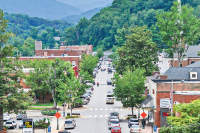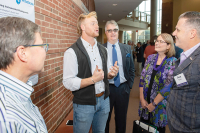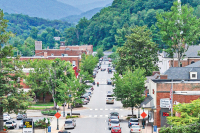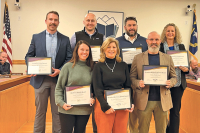Where art meets architecture
 Sam Olbekson has never met a duality he couldn’t reconcile. As the lead architect for the $110 million Harrah’s Cherokee Valley River Casino & Hotel opening near Murphy next week, Olbekson’s design will make a lasting impression of the region on millions of visitors for decades to come.
Sam Olbekson has never met a duality he couldn’t reconcile. As the lead architect for the $110 million Harrah’s Cherokee Valley River Casino & Hotel opening near Murphy next week, Olbekson’s design will make a lasting impression of the region on millions of visitors for decades to come.
An interview with Olbekson about his creative process reveals how he blended the mountain’s sense of place with the requisite excitement a casino must evoke, all the while paying homage to Cherokee culture in a modern context.
Olbekson works for the national architecture firm the Cuningham Group, which served as the lead architect on the recent multi-year expansion of the flagship Harrah’s Cherokee Casino Resort, and helped transform the Eastern Band of Cherokee Indian’s vision for a new property into a reality.
SMN: The design incorporates subtle Cherokee influences that are unmistakable yet not in-your-face. How did you strike that balance?
Olbekson: “What we talked about initially with the board was how and if you want culture to be conveyed in this project. A lot of tribal casinos use the quote unquote cliché native-looking symbols. I try to find form and aesthetics in deeper cultural places.”
SMN: The design doesn’t look like a casino you’d find in Vegas or Atlantic City.
Related Items
Olbekson: “A lot of firms are still doing the ‘80s and ‘90s design of what looks like a casino. This is going to be a very unique facility. We didn’t want a typical casino because it doesn’t honor anything. We try to push the edge of proper design. We try to be a little more creative.”
SMN: The design seems to capture a sense of place, without falling back on the typical Appalachian rustic architectural style of exposed wooden beams and stacked stone. Why didn’t you go that route?
Olbekson: “They have to be conducive to the function of gaming. People are there to be entertained, so we wanted to embody a sense of excitement, a ‘wow’ factor of something that is new, exciting and different. And then you have to look at the actual site. One of our main principals when we designed it was that every building tells a story.”
SMN: How did being a native person yourself — a member of the White Earth Band of Minnesota Chippewa — influence the way you approached this project?
Olbekson: “There are very few Native American designers out there doing this sort of stuff. I had the lens of my own experience of a native person living in a modern world and the duality of that. It aligned with my goals to help native communities in their economic development projects to ensure design and planning is done in a culturally appropriate and specific way.”
SMN: What role did the mountain landscape play in the design?
Olbekson: “We wanted a really strong connection between indoor and outdoors and a sense that this building belongs here, and on this site, not just a box plunked down on the landscape. We wanted a real sense of ‘this is meant to be here.’”
SMN: How did you do that?
Olbekson: “We walked it, we hiked it, we tried to get a sense of what are the inherent qualities of this specific site. We wanted to capture the essence and honor that. You destroy what is there when you build it, so we wanted to capture a sense of this restorative landscape. I have a box full of plant material and rocks I took from the site from day one and photos to capture the colors of the forest.”
SMN: What qualities of the landscape jumped out at you, that you wanted to capture in the design?
Olbekson: “There is a strong sense of dappled light that mystified things. You have rays of light sifting through on these misty mornings. You have the verticality of the trees and the canopy. With the design, light enters the building through the day in different ways, which resembles dappled light filtering through the forest canopy. Simply how we placed the windows — they are a series of high vertical slits in a variegated pattern.”
SMN: The color pallet, both inside and outside, features vertical panels of varying hues. What was the purpose of that?
Olbekson: “The colors and patterns are all reinforcing that sense of dappled light. We looked at how light comes in from each direction at different times of day, and chose corresponding tones. There’s an inversion effect at dusk of light coming in and out of the casino, like the sunset filtering through the trees with all these multi colored hues coming in and actually backlighting the vertices of the forest. Cliffs of color on the exterior create a sense of depth, and we repeated those inside. We wanted to break down the idea that the facade is a wall between the inside and outside.”
SMN: The roof line has a unique inverted design, with a low point in the middle and the roof line rising up on either side. What’s the purpose of that?
Olbekson: “Cultures emerge from the landscape. The landscape really tells you how to live. The roofline is a symbol of that. We tried to honor the landscape in a contemporary and modern way. The ceiling of the great hall on the interior corresponds to angle of roof line.”
SMN: How does the new casino relate stylistically to the flagship casino in Cherokee?
Olbekson: “They share design principals, but they didn’t want to mimic the existing casino. They wanted a sense of design between the two that would create continuity but they also knew it was a different target market and demographic.”









